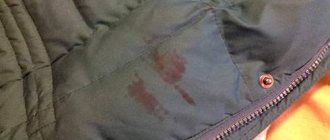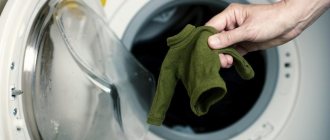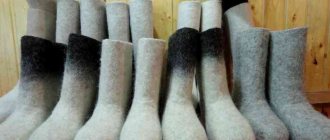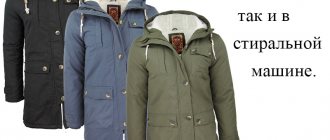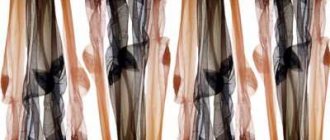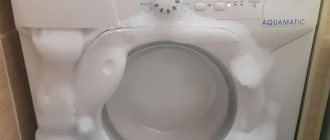Synthetic insulation has long been used as insulation for autumn and winter clothes. Environmental friendliness, manufacturability and the ability to reduce the thickness of a product without compromising thermal properties led to the emergence of padding polyester, holofiber and other materials that were originally used for sewing sportswear and work clothes. Overalls or jackets that use Thinsulate as an inner layer have excellent thermal insulation properties, are lightweight and last a long time. Like any clothing, down jackets need care, and in order to do it correctly and not spoil an expensive item, it is useful to familiarize yourself with the basic rules of washing, drying and storage.
Properties and advantages of insulation
Before you wash a jacket with synthetic filling, you need to find out a little information about it. The structure of synthetic insulation fibers makes it thin and light. Its positive properties include:
- absence of allergic immune responses, which natural fluff cannot boast of;
- heat is retained at temperatures down to -25;
- the filler is easy to care for and retains its original appearance after many washes;
- moisture from the atmosphere is not allowed to pass through, the item can be worn in the rain;
- The insulation dries quickly, does not bunch up or form gaps.
The only disadvantages include intolerance to high temperatures above 40 degrees and expensive cost. Considering how easy it is to wash the Thinsulate filler, the item will be a salvation in severe frosts for at least 5 years.
Types of Thinsulate
The performance properties of the product largely depend on the type of Thinsulate. Today you can find materials on sale that differ in composition, fiber thickness and density.
Table 2. Types of Thinsulate
| Type | Characteristics | Peculiarities |
| WITH | Thickness – 0.3–1.75 cm, density – 40–263 g/m², composition – polyester + polyolefin | The thinnest and lightest type of insulation. Withstands temperatures down to -40 °C. |
| R | Thickness – 1–2.1 cm, density – 100–230 g/m², composition – 100% polyester | The most budget option. Withstands temperatures down to -30°C. |
| TIB | Thickness – 1.7–2.5 cm, density – 98–191 g/m², composition – polyester + polyolefin | It has good ventilation properties, so the skin underneath “breathes”. Suitable for demi-season clothing. |
| IN | Thickness – 0.2–0.8 cm, density – 105–420 g/m², composition – polyester + polypropylene | Withstands extremely low temperatures and does not deform after repeated washings. |
| FR | Thickness – 1.2–1.8 cm, Density – 120–200 g/m², composition – meta-aramid + acrylonitrile + vinylidene chloride + polyethylene styrene | It has fire resistance and increased strength. Used for sewing workwear. |
How to prepare an item
Preliminary preparation is necessary before washing your Thinsulate down jacket in the washing machine. This is done in stages:
- Wash traces of dirt and stains with your hands in advance;
- Do not use bleaches or substances containing chlorine;
- increase the number of rinses, this will help completely eliminate the detergent from the insulation fibers;
- use liquid detergents appropriate for the external material and use conditioner;
- remove the collar, fur inserts, hood, and fasten.
Before washing Thinsulate, you must turn the product inside out.
Features and rules of machine washing
There are several options for washing a down jacket with Thinsulate filling: by hand or in a washing machine. The last option is the most convenient, but it is important not to harm the appearance of the outerwear. Is it possible to wash Thinsulate in a washing machine? It is described below.
- When purchasing or upon arriving home, examine the tag. It indicates the composition, permissible temperature for machine washing, ironing and drying methods. The prescribed standards from the manufacturer serve as the basis for subsequent care.
- To properly wash a jacket using Thinsulate, use the “delicate” or “hand wash” mode.
- The innovative insulation does not tolerate high temperatures; you cannot take water above 40 degrees. The spin mode should be 600 revolutions per 60 seconds.
- It is advisable to use rinse aids and detergents for rinsing and washing. When using powder, streaks are possible.
- Dry outerwear by first hanging it on hangers at the air temperature in the room. Do not resort to automatic drying.
Washing Thinsulate and caring for it afterwards is not difficult. Compliance with the rules will help keep the product in its original form and not spoil its thermal functions. Anyone can understand the instructions provided; the rules are easy to remember and avoid making mistakes in the future. Many people are interested in how to properly wash a Thinsulate down jacket with other clothes. This is done in the same way as in the situation with jeans, pullovers, and other wardrobe items. Outerwear filled with Thinsulate can be safely washed with other items. If they are different shades, use detergents for clothes of different colors.
You also need to dry it properly
In order to ensure the cleanliness and functionality of a down product, it is not enough to wash it correctly. Proper drying will help to finish the job you started and keep the down jacket in its original appearance.
The following recommendations will help you dry your washed item without loss and return it to its original appearance.
If your home appliances are equipped with a dryer, you can use it to dry your down jacket. But this drying method is not recommended due to the fact that the thermal insulation properties of the product may deteriorate.
If the choice is made in favor of this method, then a mode is set for drying synthetic materials. The air temperature should not exceed 30 degrees. After drying, the jacket is hung on hangers in a well-ventilated area and shaken periodically, “fluffed” like a pillow, shaken “upside down,” etc. These activities will allow the filler to fluff up and be evenly distributed throughout its cells.
First you need to unfasten the buttons, zippers, and rivets. The down jacket itself does not need to be turned out until it dries. It is recommended to hang the washed product on hangers in a well-ventilated area in a warm place, but not on heating devices! As the jacket dries, it is necessary to periodically shake, “beat” and shake.
If after washing it was not possible to avoid the formation of lumps, you can restore the down jacket by taking it to the dry cleaner. Or restore the filler by re-washing the product according to all the rules with special balls.
photo: depositphotos.com/AnmFoto, amnachphoto, Joe-L
Handwash
Many people are interested in how to wash Thinsulate items by hand. This does not require special preparation.
- Soak outerwear or ski suit in water up to 40 degrees.
- The container must contain the entire item, flattened. It is not advisable to compress or squeeze wet insulation. It is better to wash the product in the bathtub, and children's clothes in a basin.
- Is it possible to immediately wash a down jacket with Thinsulate that has traces of dirt on it? No. As with machine washing, stains should be washed out yourself. Typically this manipulation is done with collars, cuffs, hems and the area around the pockets. You can use a brush.
- It is better to take a liquid product, for example, a washing gel. It needs to be dissolved in warm water. Afterwards, place the clothes in the container. You can beat it with your hands lightly under water and detergent.
- The product must be completely covered with water, or the outer layer will not get wet. Only 5 minutes after opening the tap, carefully begin washing.
- Rinse the item several times under running water. This will help avoid soapy streaks.
Such methods will allow you to successfully wash a product filled with Thinsulate by hand.
Up to what temperature can you wear clothes with Thinsulate?
In accordance with GOST, winter clothing with Thinsulate is designed for temperatures from -41 to +5 °C. Certain types of insulation can withstand -60 °C. As a rule, they are used in the manufacture of workwear and clothing for professional athletes.
If you are going to sew warm clothes yourself, you must correctly calculate the amount of filler. The table will help you when purchasing material in the store.
Table 1. How much Thinsulate to take for tailoring
| Target | Insulation weight | What temperature is it designed for? |
| Demi-season jacket | 100–120 g | From 0 to -10 °C |
| Regular winter jacket, children's overalls | 150–200 g | From -5 to -20 °C |
| Warm down jacket | 250–280 g | From -15 to -30 °C |
| Work clothes | 300 g | From -20 to -60 °C |
Dry cleaning
Many owners of things with modern insulation are interested in whether a down jacket can be dry cleaned. A similar cleaning method is possible. The material tolerates aggressive cleaning agents. During the manipulation, more attention is paid to the top, the outside. Thinsulate jackets and other items are widely dry cleaned. This method is especially suitable if stains or stains appear on the items that cannot be removed by hand or by washing machine. The cost of the service is rather high, but as a result, the clothes will have their original appearance.
Production of material
The first appearance of this synthetic filler occurred more than thirty years ago. Initially, installations were used for production that were designed for heating, mixing and producing adhesive tape. As a result, a new type of light and warm microfiber synthetic insulation for clothing was obtained, which was called Thinsulate.
The material is a highly siliconized polyester fiber twisted into curls or spirals. Simply put, this is an artificial version of a down substitute. Its thickness is several times smaller than other fillers in this category. Compared to human hair, the thickness of the material is sixty times less.
Initially, the main purpose of the development was to use the fabric for astronauts and other workers who are engaged in research activities in the Arctic Circle. Which indicates an excellent ability to withstand especially low temperatures.
Drying and ironing
How to wash a down jacket with Thinsulate filling is given below, and how to dry it is also important to know.
- Place the item unfolded on a hanger. It is advisable to place outerwear or ski suit in a place where there is air flow. Thinsulate dries quickly, but the drying time is also affected by the material of the upper part. Thick fabrics take longer to dry. It is better not to place the item on the balcony or dryer, and you should also not do it near the radiator or heaters. They tend to spoil the filler. It is better to do laundry in the spring, when weather conditions do not allow you to wear warm clothes.
- Thinsulate tolerates ironing well; you can use a steamer or iron. It is important to consider the composition of the top material using the label. It indicates in what mode to iron.
Thinsulate is a modern alternative to natural down; it lasts longer and weighs less. With proper care of the product, it will last a long time and will retain heat even in severe frosts.
What to do if the filler falls off?
If the insulation has become matted, most likely the washing technology was violated: the item was washed too intensively, rinsed poorly or dried incorrectly. How to fluff up matted thinsulate?
Proper washing will help straighten out lumps of insulation, which will remove dried soap. You need to put 2-3 table tennis balls in the drum of the washing machine; they will help beat and fluff the material. After this, the damp down jacket should be laid out on a horizontal hard surface and lightly beaten with a carpet beater.
Thinsulate is a reliable, warm and durable material. With proper care, an item with this filler will serve for many years without losing its qualities.
Source
